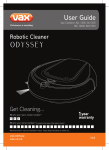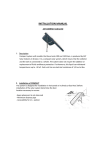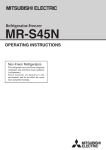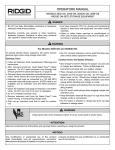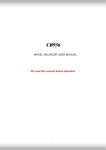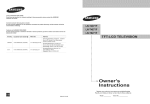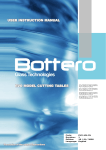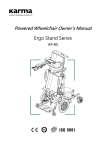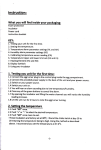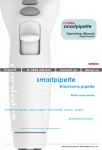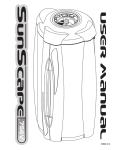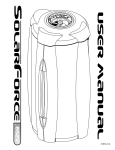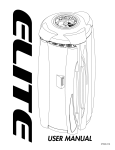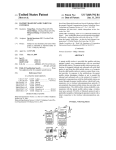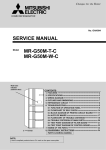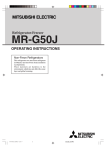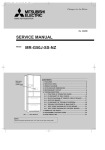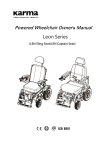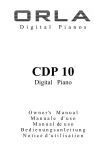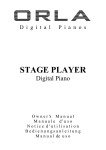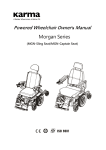Download MR-G57N - Mitsubishi Electric
Transcript
Refrigerator-Freezer MR-G57N OPERATING INSTRUCTIONS Non-Freon Refrigerators This refrigerator uses non-Freon refrigerant (isobutane) and non-Freon foam insulation (cyclopentane). These materials are harmless to the environment, and do not affect the ozone layer and global warming. User-friendly Elevating Shelves Shelves can be adjusted up or down shelf without having to remove already stored items. Storage capacity of the refrigerator compartment is maximized. Refrigerator page 14 Cool from the front side Surround Cooling System Cold air is directed into the refrigerator from the front, back and both sides of the compartment. This ensures uniform cooling throughout the compartment. Chilled Refrigerator Soft freezing Freezing Pure clear ice UV Catalyst and Lead reducing filter removes bacteria with the power of light and enhances the flavor of water. Enjoy Pure clear ice cubes using tap water or mineral water. page 20 Ice Versa Vegetable Vitamin Factory vegetable compartment Not only keeps freshness but also enhances nutrition. Just by placing vegetables inside, vitamins and polyphenols can be enhanced by the power of light. Freezer page 16 Universal Design and Layout Frequently used fridge sections are located at eye level for easy use. This feature-rich model offers many other conveniences. Non-Freon Refrigerator This refrigerator uses non-freon refrigerant and non-freon foam insulation material. Non-freon refrigerant (isobutane) and non-freon foam insulation material (cyclopentane) do not deplete the ozone layer and their contribution to global warming is extremely low, and are environmentally-friendly substances. C O N T E N T S Safety Precautions 4 From Installation to Operation 6 Smart Tips for Using the Refrigerator Meanings and Functions Setting the Refrigerator, Vegetable and Freezer Compartments Setting the Ice Making Compartment Setting the Versa Compartment Other Settings Soft-Freezing Using Compartments Food can be stored in small pieces as they can be sliced in frozen state, requiring no thawing, reducing time needed for cooking. Refrigerator Compartment Vegetable and Freezer Compartments Versa Compartment Soft Freezing (Sliceable Frozen Food) Ice Making Compartment (Automatic Ice Maker) page 12,18 Maintenance Maintaining the Automatic Ice Maker Assembling Water Supply Pump and Pipe Removing and Maintaining the Accessories Troubleshooting What to do (during blackout, during long periods of non-use and during transport) Specifications Troubleshooting Silent Design Our new original technology has enabled low noise level of 17dB(A). This refrigerator is manufactured for refrigerating and freezing foods in general households. For industrial use, please use a commercial refrigeratorfreezer. Key plastic parts of the refrigerator have the material name on them to facilitate recycling. 22 22 24 Safety Precautions Safety Precautions Warning Safety Precautions Installation Leave space around the refrigerator Leaking refrigerant can accumulate, then catch fire and explode. Leave space Danger and the degree of danger caused by improper handling are categorized and described by the following indicators. Warning Improper handling can result in death, serious injury, etc. Caution Avoid installing the refrigerator in an easily wet or highly humid area Insulation failure can cause electric shock or fire. page 6 Using extension cords and plugging too many leads into a single socket can cause heat build-up or fire. Do not wet Never attempt to dismantle, repair or alter 6 Service Call Power and power plug Remove power plug before changing interior light bulb or maintenance Non-removal of plug can cause electric shock or injury. 4 Placing heavy objects against or on, folding or bundling cord can cause electric shock or fire. Prohibited Do not pull on the power plug or cord to unplug it. Can cause electric shock or fire. Can cause damage to the cord, electric shock or fire. Do not use Dust can cause insulation failure, which may lead to fire. Prohibited Do not remove or insert power plug with wet hands. Can cause electric shock. Wet hands prohibited Remove dust Caution Be sure to follow instructions for execution In the case of malfunction or defect, immediately unplug the refrigerator and consult the retail store at which you purchased it or a Mitsubishi Electric Maintenance Service or Customer Service representative. Do not push the refrigerator on to or against the power cord. Do not damage power cord. Do not use damaged cords, plugs, or loose sockets Never touch when your hand is wet Be sure to remove the power plug from the socket Only use an outlet that meets the specified rating. Insert prongs to the root of plug firmly otherwise it can cause heat build-up and fire. Remove dust from power plug Never bring into contact or wet with water 6 If the power cord is damaged, purchase a new cord from MITSUBISHI SERVICE CENTER. Make sure that the power cord is designed for this model. Remove plug Never touch page Insert prongs to the root of plug page Never do Use a dedicated outlet for the power supply that meets the rating specified on the rating label. (The rating label is located on the door-liner of the refrigerator compartment.) If the power cord is damaged, call our MITSUBISHI SERVICE CENTER for the replacement. Improper handling can result in personal injury or damage to house, household furnishings, etc. Meaning of symbols Anchor the refrigerator to a strong wall or posts to provide against damage during earthquakes The refrigerator can tip over and cause injury. page 7 Tip-resistance Installation and transportation Anchor the refrigerator to a strong and level floor by adjusting the adjustable supports Unstable anchoring can cause the refrigerator to move and lead to injury. page 7 Install level Use transport hand-holds when transporting the refrigerator Holding other parts can cause injury. page 26 Grip hand-holds Warning Use Do not place containers with water on top of the refrigerator Wetting electrical parts can cause electric shock or fire. Do not wet Do not use electrical appliances in the refrigerator If the refrigerant leaks and contacts the electrical appliance, it can cause explosion or fire. Prohibited Do not place volatile inflammable objects inside the refrigerator Benzene, cosmetics and hair dressing products can catch fire or explode. Do not store Do not place objects on top of the refrigerator Do not store chemicals or scientific specimens in the refrigerator Use only interior bulbs with designated rating. Objects may fall when doors are opened and closed and cause injury. Items that require strict management should not be stored household refrigerators. Using non-designated bulbs can cause fire. Prohibited Do not store page 25 Designated products only Do not hang on door or door handle; do not stand on compartment doors Do not touch the machinery of the automatic icemaker (located above the ice storage bin) Do not damage the refrigerant circuit or the pipes nor mount anything with screw The refrigerator may tip over and cause injury. Can cause injury when icemaker plate revolves. The refrigerant is flammable, which can cause explosion or fire. Prohibited If you notice gas leakage, do not touch the refrigerator. Open windows to ventilate. Sparks from electrical contacts can cause explosion or fire. Ventilate Do not touch Prohibited Do not wash with water or spill food liquids on the refrigerator Do not place combustible sprays near the refrigerator Water and food liquids can cause electric shock or fire. Immediately wipe clean wet surfaces. Sparks from electrical contacts can cause inflam-mation or fire. Do not wet Do not use Malfunction and long-term storage If the refrigerant circuit is damaged, do not touch the refrigerator and avoid using flames nearby. Open windows to ventilate. In the event of malfunction (when you detect a burning odour or other abnormality), remove the power plug from the socket turn off the refrigerator If the refrigerant circuit is damaged, consult the retail store. Continued operation during malfunction can cause electric shock or fire. Ventilate Can cause injury, electric shock or fire. Remove plug When refrigerator is not in use for a long period, remove the door seal When the refrigerator is not in use for a long period, remove the power plug from the socket and open the door to dry the refrigerator Children can be put in danger if they are trapped inside the refrigerator. If not dried sufficiently, refrigerant (gas) can leak due to condenser corrosion and cause explosion or fire. Remove seal Do not attempt to dismantle, repair or alter Dry Do not dismantle This refrigerator uses flammable refrigerant and foaming gas for insulation. Please deliver the unit to specialized industrial waste dealer when you wish to dispose of it. Please follow the rules in your country. Dispose of properly Caution Use Do not excessively pack with food items, or remove shelves or open doors with excessive force Can cause food items Prohibited to fall and injury. Do not place bottles in the freezer compartment Do not eat smelly or discoloured food Can cause injury if content of the bottle freezes, causing the bottle to shatter. Can cause food poisoning or illness. Do not touch food items or containers in the freezer compartment with wet hands Do not put your hands or feet underneath the refrigerator Can cause frostbite. Wet hands prohibited Do not store Steel plates, etc. can cause injury. Do not touch Prohibited Close the door using the door handles Be careful not to catch fingers in the door when you hold it. Can cause injury. Hold door handle 5 From Installation to Operation From Installation to Operation At least 10cm Dedicated outlet that meets the specified rating. At least 2cm Install the refrigerator. Installation area The installation area should not be exposed to direct sunlight or hot air, and should be well-ventilated to avoid diminished cooling power and to economise on the cost of electricity. It should have little humidity to prevent rusting It should be strong and level to prevent vibration and noise, half-shut doors, and tilted doors. Install a strong plate or board under the refrigerator if the supports easily sink into the floor. (For prevention of deformation or discoloration due to heat or weight) A place away from other devices Prevention of television noise or image disturbance. Leave space for heat ventilation Leave at least 2cm of space on the right and left and 10cm of space between the ceiling and the top of the refrigerator to allow heat to escape from the ceiling and the sides of the refrigerator Heat builds up in exterior walls of the refrigerator When the refrigerator is first used and during the summer heat build-up can exceed 50-60˚C Warning Do not close the ventilation hole of the refrigerator or the crack around the refrigerator. If the refrigerant leaks, ignition or explosion may be caused. Do not cause damage to refrigerant circuit (piping) / Do not attach screws. Non-freon refrigerants are flammable gas. However, it is hermetically sealed, therefore, leaking is infrequent. Warning Just in case of having damaged the refrigerant circuit. 1. Do not use electric items or fire equipments near by. 2. Open the window and ventilate the room. And then contact the retail store you have purchased from for further instructions. 6 Connect the power supply. *Connect power supply soon after installing the refrigerator. Use a dedicated outlet Use a dedicated outlet for the power supply that meets the rating specified on the rating label. (The rating label is located on the door-liner of the refrigerator compartment.) Warning Using outlets that do not meet the specified rating or plugging in too many leads into a single socket can cause heat build up or fire. The refrigerator will not be damaged even if the power is supplied soon after installation. It takes a while for the refrigerator to cool, therefore supply power as soon as possible. Electrical Connections Make sure this unit is properly grounded. The unit should always be plugged into its own electrical outlet. This will provide the best performance and prevent electrical circuits from being overloaded and causing a fire. Make sure that the electrical outlet provides the proper voltage. Extension cords are not recommended. If your unit is installed in the high humidity location, not only ground connection but also installation of an earth leakage breaker is recommended. If the power cord is damaged, purchase a new cord from MITSUBISHI SERVICE CENTER. Make sure that the power cord is designed for this model. If the power cord is damaged, call our MITSUBISHI SERVICE CENTER for the replacement, in order to avoid a hazard. Turn each adjustable support in the arrow direction until they touch the floor. Use your refrigerator efficiently to save electricity adjustable support caster Leg cover Leave space between items in the refrigerator. Adjustment and Anchoring Leg Cover Turn the adjustable supports until they touch the floor and the casters are raised from the floor Insert into the bottom space from the front side of the refrigerator. to prevent vibration and noise, transmigration and half-shut doors Caution (The leg cover is bundled in the refrigerator compartment before shipment from the plant.) Insufficiently adjusted supports can cause injury due to migration of the refrigerator. Level the refrigerator left to right, with the front of the refrigerator raised slightly, so that the doors close easily and to prevent half-open doors. Adjusting tilted doors and an uneven refrigerator If the installation area is not level or the refrigerator supports sink after a few days due to the weight of the food, the door will appear lower. (Depending on the quantity of food, the food weight can exceed 100 kg.) Turn the adjustable support in the direction given below for readjustment. How to attach leg cover 1Pull out the freezer compartment door and take out the case. page 25 2With the freezer door open, insert the nail of leg cover into the handle hole in the length direction as far as possible. Handle hole The right door sags down Leg cover The left door sags down adjustable support right left rear support For example, if the refrigerator is installed in the corner of a room, one of the rear supports may sink into the floor. Use a caster stand (sold separately) or strong plate at the rear of the refrigerator. (In general, the plate should be 2-3 mm thick.) To obtain a caster stand, contact your retail store. Allow large quantities of food to cool before storing. Frost build-up can cause decline in cooling ability as a result of even the slightest door opening Be sure not to catch food items, plastic bags, power cords, etc. in the door when you close it. Helpful storage hints wipe Leg Handle wrap Nail 3Push down until the leg cover is almost level. Prepare for earthquakes Securely pack foods with strong odours for storing. Foods that tend to spread odour Thread strong belts through the 2 handy-grip recesses on the top-rear of the refrigerator and secure them to the wall, posts or another strong area Strong belts Avoid opening and closing the door unnecessarily and leaving the door open for a long time. Make sure that leg cover surface is level Pickled scallions, dried fish, fermented soybeans (natto), miso, beef, pickled radish, sardine, hot Korean pickles, Chinese meat dumpling, etc. Foods that tend to be affected by odour Pudding, ice cream, potato salad, tofu, rice, bread, milk, cake, ice, etc. Warning Your refrigerator tipping over can cause injury. The deodoriser cannot remove odour completely. 7 Smart Tips for Using the Refrigerator Meanings and Functions The Display and their Meanings This control panel displays “What is selected for the ice making compartment” and “What is the set temperature” for the refrigerator, versa, vegetable and freezer compartments. The product is set at “M” for refrigerator, vegetable and freezer compartments, “REF” for versa compartment and “REG” for the ice making compartment at the time of installation (purchase). Short note for users: The display will turn off after 30 seconds if no button is pressed. The display will come on if any button is pressed. Display panel Compartment display The selected compartment is illuminated. Temperature control display The temperature control mode of the selected compartment is displayed. Selection buttons Press this button to change the compartment displayed. Refrigerator is pressed. Versa page 10,12 Press this button to select the temperature control mode. For refrigerator, vegetable page and freezer compartments For versa compartment page 10 12 QUICK (HOLD 3 SEC) button Freezer Press this button for fast cooling. Vegetable For refrigerator, vegetable page and freezer compartments For versa compartment page Note Do not keep pressing (about 3 seconds) . Pressing this button for a long time will reset the control panel. Do not press for a long time except when you want to reset the panel. 8 Illuminated during quick cooling. SELECT button ROOM button The display changes each time QCK display 10 12 Short note for users: Fast cooling cannot be performed when the versa compartment is set at soft freezing mode. Pressing “QUICK” will cause the buzzer to emit “peep, peep” tone.) Ex.: How to read indications when the versa drawer compartment is displayed It indicates the versa compartment is selected now. Refrigerator Ice making It indicates that the temperature control for the versa is set to “soft freezing/medium” level. The ice making mode for the ice making compartment is set at “Regular”. Versa Vegetable Freezer ECO display Illuminated during energy-saving mode. page 13 Ice making compartment mode The selected ice making compartment mode is illuminated. page 11 Child safety lock When this indicator is displayed, it rejects any mischievous tampering or unintentional pressing of control panel settings. page 13 Short note for users: If all indicators blink 3 times every 30 to 60 seconds or if the compartment display and temperature control display on the control panel repeatedly, it means that the refrigerator is in demonstration operation mode. The refrigerator suspends its cooling function during this mode. The demonstration operation mode must be cancelled manually. page 26 ECO button Press this button to select energy-saving mode. page ICE SELECT button Press this button to change the ice making mode or to stop ice making or to start fast cooling. page 11 ICE MAKER CLEANING (HOLD 5 SEC) 13 Press this button to clean the ice tray. page 23 Note Do not press the button for a long time unless you want to select ice maker cleaning. Otherwise, the ice tray will be cleaned (rinsed). Do not press and hold the button unless you want to clean (rinse) the ice tray. 9 Smart Tips for Using the Refrigerator Setting the Refrigerator, Vegetable and Freezer Compartments Setting at the time of installation (purchase) Refrigerator Vegetable Freezer Refrigerator Temperature control Vegetable Freezer Display the compartment which you want to control the temperature. Check here to control the temperature. * The above illustration is an example. Settings may be different according to the selected mode. Press Fast cooling Display the compartment which you want to control the temperature. is displayed during fast cooling. * The above illustration is an example. Settings may be different according to the selected mode. to display the compartment Fast cooling is used for home freezing or cooling bulk purchased foods fast. you want to change the temperature control mode. The display will change at each press. Press to display the Press to change the temperature compartment you want to cool fast. The display will change at each press. control mode. The display will change at each press. Refrigerator Vegetable Freezer Compartment display Temperature control Too cool 2 to 3°C higher than “M” level 2 to 3°C higher than “M” level 2 to 3°C higher than “M” level Slightly cool 1 to 2°C higher than “M” level 1 to 2°C higher than “M” level 1 to 2°C higher than “M” level Around 0 to 6°C Around 3 to 9°C Around -16 to -22°C Slightly cooler 1 to 2°C lower than “M” level 0 to 1°C lower than “M” level 1 to 2°C lower than “M” level Much cooler 2 to 3°C lower than “M” level 1 to 2°C lower than “M” level 2 to 3°C lower than “M” level Standard * The above shows only rough standard. The temperature may vary according to the usage conditions, such as how foods are stored and opening/closing frequency of refrigerator door. Temperature control mode for the versa compartment page 12 and hold for 3 seconds Press (Until a “beep” sound is heard) indicator comes on. The cooling is automatically completed after about 2 hours. indicator goes off. To stop the operation halfway through Press and indicator comes off. Short notes for users: The temperature inside the refrigerator may temporarily increase or decrease before and after defrosting. The temperatures given above represent the temperatures measured after reaching stabilization at the lower center part of the refrigerator when the ambient temperature is 30°C and the doors closed with nothing inside. 10 Fast cooling of versa compartment page 12 Short note for users: During Fast cooling, the noise from the refrigerator will become higher due to high speed cooling. Setting at the time of installation (purchase) Setting the Ice Making Ice Making Compartment Ice making Selecting ice making modes Display the ice making compartment Short notes for users: The display will turn off after 30 seconds if no button is pressed. The display will come on if any button is pressed. Quick ice making mode repeatedly Press to display . Ends automatically It automatically completes after operating for about 9 hours, when the ice storage bin is full of ice (about 60 to 100 pieces) or when no water is left in the water tank. indicator goes off and then indicator goes on. * The above illustration is an example. Settings may be different according to the selected mode. Press repeatedly to make your To improve clear ice To increase crystal ice making time required ice maker setting blink. The display will change at each press. Press Ice making mode can be selected from 4 types. (Regular ice making) Select this mode when you want to make a large quantity of ice. (Quick ice making) Select this mode when you want to make ice quickly. (Crystal ice making) Select this mode when you want to make crystal clear ice. It will take more time compared to “REG” mode (about 5 to 8 hours). not use ice such in winter time. The compartment can be used for frozen food storage. Before using this compartment as a freezer, clean the water supply system. page 23 and simultaneously and hold for about 3 seconds. (Until a “beep” sound is heard) indicator turns on and whichever applicable, will blink. Displays of other compartments will be extinguished temporarily. Blinking Press (Stop ice making) Select this mode when you do , repeatedly and select “H” if you want to make clearer ice cubes or “L” if you want to increase crystal ice making time. The selected mode will blink. After a while, a “beep” sound is heard and the blinking display is left and after 2 seconds, it will stay lit and the mode is set to the lighting display. Display of other compartments will be reset to the previous display. Selecting “L,” “M” or “H” will light only Short notes for users: During “QCK” mode, the noise from the refrigerator will become higher due to high speed cooling. The ice making time differs according to the ambient temperature and conditions of usage. . Settings for crystal ice making time and clarity Display L M H Ice making time Faster than “M” About 5 to 8 hours Slower than “M” Clarity (percentage 70 to 80% of ice 80 to 90% of ice 90% or more of ice of clear area) It is set at “M” at the time of installation (purchase) Immediately after installation, it may take more than 24 hours to make ice even if “QCK” mode is selected. 11 Smart Tips for Using the Refrigerator Setting the Versa Compartment Versa Temperature Control Versa compartment is displayed. Check here to control temperature mode. * The above illustration is an example. Settings may be different according to the selected mode. Press Press and display Setting at the time of installation (purchase) Versa Fast cooling Versa compartment is displayed. is effective when , is selected. or is illuminated during fast cooling. * The above illustration is an example. Settings may be different according to the selected mode. . Fast cooling is used for home freezing or cooling bulk purchased foods fast. Fast cooling is OK with food inside. After Fast cooling the temperature will be reset to its previous set temperature. repeatedly and change to make your required temperature control mode. Versa compartment can be selected page 17 from 6 choices. Press and display Press and display . , About 3°C , whichever is applicable. * No Fast cooling for About 0°C and hold for 3 seconds Press (Until a “beep” sound is heard) About -7°C (M) is displayed. The cooling is automatically completed after about 2 hours. indicator goes off. About -17°C To stop the operation halfway through Short notes for users: The temperature inside may increase or decrease temporarily before and after defrosting. The temperatures given above represent the temperatures measured after reaching stabilization at the lower center part of the refrigerator when the ambient temperature is 30°C and the doors closed with nothing inside. If soft freezing is selected, freezing takes place at about -7°C and it may take about 24 hours until the food is completely frozen. 12 Press and indicator goes off. Short notes for users: When the versa compartment is set at soft freezing mode, fast cooling will not take place. Press QCK until a “beep” sound is heard. During fast cooling, the noise from the refrigerator will become higher due to high speed cooling. Short notes for users: Other Settings The display will turn off after 30 seconds if no button is pressed. The display will come on if any button is pressed. Child Safety Lock Energy-saving Running lights on If rejects any mischievous tampering or unintentional pressings of control panel settings. Press at the same time and hold for 3 seconds. (Until a “beep” sound is heard) turns on. To cancel Follow the operation explained above. * Even if child safety lock is on, compartment can be selected When there’s no opening or closing of door during night time or when you are not home. The refrigerator automatically switches between Energy-Saving Operation Mode and Normal Operation Mode to minimize the energy consumption. Press If you want to reset To reset “ROOM”, “SELECT”, “QUICK” and “ECO” to the mode they were set at the time of installation. and hold for Press on the panel lights. about 3 seconds. (Until a “beep” sound is heard) Press ECO button again. Selected modes at the time of installation To cancel ROOM Refrigerator SELECT Vegetable Freezer QUICK • ECO Indicators go off Temperature control of versa compartment will not change. If the ice making compartment was set at , it will be . It will be the same as when other settings were made. 13 Using Compartments Refrigerator Compartment Short notes for users: Interior light The interior light will turn off temporarily if it is lighted for 60 minutes continuously. Close the door thereafter and the interior light will turn on each time the door is opened. Elevating Shelves Two-way Flexishelf Change pocket (large) Change pocket (small) Elevating Shelves Bottle pocket (large) Rotating partition The rotating partition may get damaged, when it is turned up Lid of slide chilled case Slide chilled case Bottle pocket (small) Door alarm If one of the doors is left open for more than 1 minute, a “beep” sound is heard, notifying fridge temperature and energy efficiency are affected. (Refrigerator compartment, ice making compartment and freezer compartment) Prevents wasteful leakage of cool air and reduces wasteful power consumption. Free egg shelf Small item case Two-way Flexishelf 1 As a wide shelf Elevating Shelves Move the lever on the front of the shelf left or right to adjust the shelf to the desired position. 2 Make the shelf to the half size for taller foodstuffs Move the lever to the right to raise the shelf. Move the lever to the left to lower the shelf. The lever will be difficult to move when heavy items are placed on the shelf. When the Elevating Shelves are lowered, one of the shelf supports may come off if the shelf contacts any foods under the shelf. To prevent from any damage of foods. If one of the supports comes off, push it back into position from above. How to remove the shelf page 14 24 Change pocket Each pocket at the right and left sides can be hung in two different positions. Note Do not leave food items hanging over the edge of the shelves. Do not place bottles that can not reach the bottom of the compartment in the front row of the bottle pocket. Doing so can cause half-shut doors and broken bottles. How to remove the pockets page 25 Lid of slide chilled case Open the lid by pulling the case toward you. In the following cases, the items in the slide chilled case may be frozen. Please set the refrigerator compartment temperature to “M”, “LM” or “L”. When the temperature for the refrigerator is set to “H” When the ambient temperature becomes 5°C or less (in winter) Do not close the door of the refrigerator with the items in front of the slide chilled case The case is automatically set to “CHIL”. The temperature cannot be adjusted using the control panel. To store meat, fish, processed foods (such as fish paste, ham, etc.), yogurt, etc. Small item case The case can be used for storing various items including eggs and small articles according to your idea. The case is automatically set to “CHIL”. Do not store food that freeze easily. Be sure to properly replace and cover the case with the lid Do not set a commercial tube stand outside the door pocket Failure to do so may prevent the door from closing properly, cause insufficient cooling, items to drop from shelves, injury and damage to the case or lid. Set the large tubes at the back Not doing so can cause the tubes to fall out from its original position. 15 Using Compartments Vegetable and Freezer Compartments Slide case Vegetable case Note 2L PET bottles can also be stored. Do not place tall objects under the slide case Vegetable pocket Asparagus and cucumbers can be stored upright. Tall objects may cause damage to food or the slide case. If the slide case was removed and not used, it may cause the vegetable compartment to get dry. LEDs (Top of the compartment) Lighting up vegetables to enhance vitamin and polyphenol Vegetables are still alive even after they are harvested. Exposure to light can enhance nutritiousness of vegetables. *Orange LEDs 3 locations Those LEDs are always on. *Purple LED 1 location *Blue LED 1 location LEDs are controlled to illuminate for 160 minutes per day. They may be off when you open the door. Note Do not disassemble or spray water on the LEDs. Water penetration may cause malfunction. As long-life LEDs are used, normally, no replacement is necessary. Short notes for users: There are no such foods that cannot be stored under the LED light. Simply store them in the usual manner. Even with poor light, vegetables increase nutrients. Then there is no need to unwrap the covers, unless they shut out the light. Cover vegetables and fruit in plastic wrap to preserve freshness. Vegetable nutrients will not continue to increase forever. The storage stability will depend on the freshness when bought. Please use the freshest vegetables available. The vegetable compartment has high humidity, therefore the bottom of each case may become cloudy or condensation may form when a large amount of leafy vegetables is placed in the vegetable compartment. If condensation collects in the bottom of a case, it will cause the case to become dirty, therefore wipe the case with a dry cloth. Door alarm Freezing case (top) Freezing case (bottom) Note For freezing only Freezable 500 mL PET bottles can be placed in upright. Do not place anything other than freezable PET bottle beverages. Frozen liquid may cause the bottle to break. page 16 5 If one of the doors is left open for more than 1 minute, a “beep” sound is heard, notifying fridge temperature and energy efficiency are affected. (Refrigerator compartment, ice making compartment and freezer compartment) Prevents wasteful leakage of cool air and reduces wasteful power consumption. Food storage limit line Do not place food items over storage limit line in the lower freezing case. Door could not be totally closed and could damage food items or the freezing case. Versa compartment Versa case Aluminum tray Food is cooled quickly due to pre-cooled aluminum. Note If the setting for this compartment has been changed from refrigeration or chilled to freezing or soft freezing, do not place frozen food inside until an elapse of at least 30 minutes Place the food items so that the cool airflow can flow above the items. Chilled Select the setting according to your dietary needs. page 12 Refrigerator Soft freezing Freezing You can select from 6 types app. 3°C Refrigerator For cooling beverages If food cannot fit into the refrigerator compartment app. 0°C app. -7°C (medium) app. -17°C For storing processed food, (such as fish paste, ham, etc.), yogurt, cheese etc. for about 1 week. Chilled Soft freezing For storing meat or fish for about 2 to 3 weeks If food gets too hard to cut through set at “L” and if food does not get frozen easily, set at “H”. Freezing For storing frozen food, ice cream, etc. For storing meat, fish or other processed foods for about 1 to 3 months. Short note for users: The temperatures given above represent the temperatures measured after reaching stabilization at the lower center part of the refrigerator when the ambient temperature is 30°C and the doors closed with nothing inside. The temperature may vary according to the usage such as storage condition of foods and door opening/closing frequency. ( Short term frozen food storage ) 17 Using Compartments Soft Freezing (Sliceable frozen food) Items that are not suitable for soft freezing Soft Freezing Meat and Fish Items that can not be frozen normally are not suitable for soft freezing either. Form and quality of such items after freezing are not guaranteed. Example: konyaku (nutrition yam paste), bean curd, milk, eggs, potatoes, etc. Though your meat or fish may seem as frozen as if it were frozen normally, with soft freezing you need not separate food or wait for it to thaw because your meat or fish can be cut with a knife immediately after you remove them from the versa compartment, thereby shortening your cooking time! Items that have been transferred from freezer to soft freezer or soft freezer to freezer should be used within 1-2 weeks. Blocks of meat The soft freezer cannot preserve commercial ice cream or frozen foods. Store these items in the freezer compartment. Meat that has been stored in the freezer or was bought frozen can be transferred to the soft freezer, so you can divide up and remove only the amount that you want to use. Depending on its size, your meat should be ready to cut within 2-5 hours after it is transferred to the soft freezer. Thinly sliced meat or bacon Thinly sliced meat or bacon can be cut immediately. They will thaw while cooking or dipped in basting, during which time you can easily separate them. They may not be able to be separated immediately after they are removed from the soft freezer. Ground meat You can cut and remove the amount you want to use. Furthermore, if you cut them into small cubes, they will thaw enough in 15-30 minutes for you to loosen with your hands. Cutlets and cod roe Cutlets can be cooked on a low flame without taking the time to thaw them. Cod roe and other highly salted foods do not freeze and can be used immediately. 18 Fruit The soft freezer is recommended for very sweet fruit. Try soft freezing with various fruit. Eat fruit frozen without thawing. (these fruit will not be fresh again after thawing) The flavor of fruit kept in the soft freezer for more than 1 week may change. It is recommended to eat fruit within 2-3 days to best enjoy its new taste. Freezing time may vary depending on sugar content of the fruit, so allow 1 day for freezing. Others Meat sauce Store left over sauces in an airtight container. You can remove the sauce with a spoon and use it as a universal sauce with gratin or omelets. Sauces with high liquid content may not be removable with a spoon. Line the inside of a storage container with plastic wrap, pour sauce into container, remove by holding the wrap and cut the amount you need with a knife. Smoothie Blend soft-frozen fruit and yogurt and milk in a blender to make an easy healthy drink. Example: Cut half a peeled apple into bite-size pieces, and a peeled kiwi into 1-cm circular slices. Freeze fruit in the soft freezer. Then blend soft-frozen apple and kiwi, 250cc of milk and honey (if you like) in a mixer until it becomes smooth. (makes 2 servings) Watermelon Spinach Boil spinach, place it in an airtight container and soft-freeze for later use in miso soup or butter saute. Make watermelon ice by cutting watermelon into bite-size pieces and freezing in the soft freezer. Fermented soybeans and fried bean curd Canned fruit Soft-freeze mikan oranges or pineapple in its syrup to make easy sherbet. May not freeze depending on the sugar content of the syrup. Fermented soybeans can be mixed immediately after removal from the versa compartment. Chilled fermented soybeans can be quite tasty. You can cut the amount of fried bean curd you want to use. Short notes for users: Please pay attention to the following when using soft freezing Since food freezes takes place at approximately -7˚C with soft freezing, it may take up to 24 hours for food to freeze completely. Open and close compartment doors with as low frequency as possible when you add items to the soft freezer. The degree of freezing may vary depending on the type of item, cooking method, arrangement of item (folded and layered or location of item), amount, and period of storage. Items may not freeze or may freeze too much (for cutting with a knife) depending on content of sugar, salt and fat. Items that have frozen too much can be cut with a knife if they are left in room temperature for 5-15 minutes. Adjust the temperature in accordance with degree of freezing. page 10 When not frozen enough Adjust soft freezing setting to “H”1-2˚C below “M” Foods that do not freeze easily Food with high salt content, such as cod roe Food pre-seasoned with soy sauce or bean paste Food with high sugar content, such as stewed beans Food with high sugar content, such as bananas When frozen too much Adjust soft freezing setting to “L”1-2˚C above “M” Foods that freeze easily Food with high water content, such as boiled vegetables Food with high water content, such as rice Large blocks of meat with low fat content, such as thigh meat 19 Using Compartments Ice Making Compartment (Automatic Ice Maker) Your first batch of ice Ice making Water supply port cap Discard the first 2-3 batches of ice you make or ice that is made after more than 1 week of nonuse (about 20 cubes). This ice often has bad odour or dust on it. Water tank lid Pipe, water supply pump, light-type bacteria removing filter with Lead-removal function Water tank (app. 1.2L) Pipe V-LED lamp Bring light to light-type bacteria removing filter to prevent the bacteria from being bred in the water tank. (The automatic ice maker must be cleaned regularly. page 22 ) Ice tray Can not be removed. Soundproof mat Ice storage box The soundproof mat reduces the sound of ice dropping into the storage bin. Do not remove the mat. Ice server Door alarm If one of the doors is left open for more than 1 minute, a “beep” sound is heard, notifying fridge temperature and energy efficiency are affected. (Refrigerator compartment, ice making compartment and freezer compartment) Prevents wasteful leakage of cool air and reduces wasteful power consumption. Note Door Please do not put anything deep inside the ice storage bin. Ice server Ice storage bin Make the ice flat. Ice level sensor lever (Detects the ice storage level) When storing food items in the ice storage bin, they must not be higher than the top of the bin. (This can cause a malfunction or prevent the door from closing.) The ice level sensor lever will detect the ice storage automatically, and will stop ice making when it reaches a certain amount. (app. 60 to 100pcs.) In order to detect the ice level correctly, please make the ice flat and put the ice server in the front of the ice storage bin. The automatic ice maker could be damaged if it contacts an object. 20 Do not poor anything like sugar, juice, tea or soft drinks, in the water tank. (Heat resisting temperature, app. 60°C) Placing liquid other than water may cause damage to the automatic ice maker or water supply pump. Do not fill the water tank higher than the full-level mark. Filling the water tank with a kettle while it is still in the tank holder, or filling it higher than the full-level mark may cause “connected” ice to form. Making Ice Select , Ice shapes The shape of ice is trapezoid but somewhat flat and uneven or on the control panel. page 11 The size of ice made for one time may vary with the water Initial setting of the ice making compartment at installation is . amount in the water tank. One batch of ice is 5-8 pieces. If the water tank is filled above the full-level mark, the water Check the amount of water remaining in the water tank. Open the door to the refrigerator compartment and check the level from above the tank. channels in the ice tray will freeze, causing 2-3 pieces of ice to stick together and bumpy ice. If some pieces of ice stored long time, they will be stuck or become smaller. (This phenomenon is called “sublimation”.) Remove the water tank. Remove the water supply port cap and fill the tank with water. Up to the full-level mark The quickly made ice may be cracked or split due to fast freezing. About Crystal Ice Replace the water tank holding it level. Tipping the tank will cause water spillage. If the water tank does not fit properly in place, ice will not be made. In addition, it can cause the water tank to freeze. Check that there is no foreign material in the tank When you want to change the clarity of the ice or the ice making time operation page 11 holder or water supply pipe. Ice making time Approximate time for making one set of ice Quick ice making mode 60-90 minutes Regular ice making mode 100-120 minutes Crystal ice making mode There may be white sediment (white crystal) or bubbles inside the ice cube. In cases below, may cause clear ice into such white sediment ice. • When the mode has been changed from “REG(Regular), “QCK (Quick)”, “STOP(Stop)” to “CRL(Crystal)”. (It is set at mode at the time of installation). • Ice made of water containing much mineral. (This white sediment is a crystal of mineral ingredients) • When surrounding temperature, status of use have changed. • When pieces of ice are stored long time in the ice storage bin. (Frost will cover the ice. If it is put into water, the frost will dissolve.) 5-8 hours One batch of ice: 5 to 8 pieces Clear ice is made slowly to increase the clarity of the ice cube. The time may vary according to the ambient temperature of the refrigerator or its usage condition and the type of water used. It may take longer time than given above. It is recommended not to open or close the ice making compartment door, when making clear ice. Short notes for users: Ice made of water containing much mineral such as mineral water might cause white sediment (white crystal). When the ice melts into water, it may appear fibrous. This white sediment is a crystal of mineral ingredients, which is not harmful. The V-LED lamp comes on in the following condition. • When the door of the refrigerator compartment or ice making compartment is kept open (However, the lamp goes out when the door is kept open for 5 minutes.) • Before and after feeding water into the ice tray. The time required for making ice might be longer according to the frequency of closing and opening the door, the temperature around the refrigerator, and the amount and temperature of the water added to the tank. 21 Maintenance Maintaining the Automatic Ice Maker Cleaning once a week Water tank Cleaning once a month Water supply pump / Light-type bacteria removing filter Remove the lid and wash with water. Pull out the pipe. Twist the pump to remove it. (the tank can withstand up to approximately 60°C) Disassemble and wash the parts with water. Water supply pipe / Tank holder Water supply pipe Light-type bacteria removing filter Cap Cover Tab Note Do not use kitchen detergent, benzene, bleach or other cleaning products to clean the light-type bacteria removing filter. Be sure to read all instructions for detergents, bleach and other cleaning products you use to clean the water tank and lid. Separate pieces and wash with water. Aluminum pipe Packing Twist on the aluminum pipe to replace it. *The water supply pipe may be white due to minerals or chlorine, but this is not abnormal. Wash the pipe and continue using it. Reverse steps to replace the pipe. Reassembly points Improper reassembling might cause failed ice making or increased noise. Check the following. Fit the filter cover’s tab (1) Align the marks on the and hook (2) into the cap. pipe and the water tank. Water tank mark 1 Rotate the cap and catch the cap hook (1) onto the water supply pump tab (2). Rotate *Make sure that no foreign object is found between the water supply pipe and the pipe junction. Pipe junction Water tank 1 *Make sure that the impeller is in the pump. Securely rotate the water supply pump into the water tank to install it. Rotate Pipe Impeller 2 Replace the water supply pipe. Be sure that sides A and B fit flush against each other. Otherwise, the ice maker may malfunction if the pipe is not installed properly. 2 Light-type bacteria removing filter Side A Water supply pipe While pushing the tab downward with your finger, pull the cover off. Reverse the steps to replace the pump. Do not let water flow into the tank holder. 22 2 The products above give ice odours. Tank holder Side B Pipe The impeller is magnetic. Wash carefully to remove all foreign objects. Normally the filter need not be Pipe replaced. However, replace it in the following conditions: • When the filter is clogged by Water supply passing something other than pump water through the filter • When the filter is broken • When the filter is moldy Impeller In such cases, contact the retail store at which you purchased this refrigerator. Cleaning once a month Pull out water supply pipe. Wipe the tank holder with clean cloth. 1 Water tank Water tank Be careful not to pinch any foreign object. Water supply pipe Pipe Insert horizontally Tank holder (on the refrigerator body) Improper fitting or any foreign object will produce a clearance between the pipe and the pipe junction to cause freezing of the water tank. Regular cleaning produces clean and delicious ice. Regular cleaning prevents water stains, molding, etc. To clean (rinse) the ice tray Cleaning the ice tray using water from the water tank Remove ice from the ice storage bin and close the ice making compartment door. Remove ice When the automatic ice maker will not be used for a long period of time When using the setting *Follow these instructions for transportation of the refrigerator as well. Discard all the ice and water from the ice tray in the ice storage bin to empty the ice tray. Remove the water tank and close the ice making compartment door. Water tank Ice making compartment Fill the water tank with water and set it in place. Press on the control panel and hold for about 5 seconds (Until the buzzer emits “peep, peep” tone.). The display ( , , , or ) of the ice making compartment will blink (for about 1 minute ). (The water and ice will empty from the ice tray.) After the blinking stops, the original display will return. Press on the control panel and hold for about 5 seconds (Until the buzzer emits “peep, peep” tone.). The display ( , , , or ) of the ice making compartment will blink (for about 1 minute ). (The ice tray will be cleaned by the water from the water tank.) Remove the ice storage bin and discard the water and ice. Do not discard the two-layer soundproof mat. Ice storage bin Set the ice making compartment page 11 to . Repeat step 2 to 3 times. Remove the ice storage bin and discard the water and ice. Do not discard the two-layer soundproof mat. Wash the water tank (water pump, pipe, and light-type bacteria removing filter), water supply pipe, ice storage bin, and soundproof mat with water. Dry carefully and reinstall parts. To restart the ice maker, switch the ice making setting. page 11 Put the water tank back to its original position. Ice storage bin 23 Maintenance Removing and Maintaining the Accessories Before you start Remove the power plug from the socket. Warning Failure to remove the plug may result in electric shock. Wait at least 10 minutes before you replace the power plug. The refrigerator will not operate if the plug is replaced immediately after it is removed. Maintenance and Cleaning Wipe or remove and wash parts with water. To remove oily deposits, wet a cloth with warm water or dishwashing detergent and wipe. (Be sure to wipe off all oily deposits. Oily deposits can cause plastic parts to break.) Be sure to wipe off any detergent you used. Be sure to read all instructions and heed precautions for chemically treated disposable cloths you use to clean parts. Do not use alcohol, benzene, steel wool or alkaline-base detergents. They will cause damage to plastic parts (door handles, cap, cases, etc.) and coating. Elevating Shelves Removal Installation 1Move the lever completely to the right. 1Make sure that the lever is moved completely to the right. 2Push up each support, one at a time, with a strong effort. (4 supports) (When the internal hooks are released from the refrigerator, a “click” sound will be heard.) 1Push up the nails at the back side of tray (3 places) using fingers. 2Make sure that the 4 metal stoppers are securely fitted into the refrigerator, then lightly set the shelf into the refrigerator and align the 4 supports with the 4 stoppers. 3Push each of the 4 supports, one at a time, downward from above. (When the internal hooks catch onto the refrigerator, a “click” If the supports are not released easily, sound will be heard.) push the internal hooks inward. 3After the 4 supports are released, pull out the shelf. Tray removal 4Finally, move the lever to the left and right and check that the shelf moves up and down while remaining level. (If the shelf does not remain level, the 4 hooks are not securely caught onto the refrigerator. Remove the shelf and repeat steps 1 to 4.) 2Lift up the back side of tray until the nails at the front (3 places) and nails on both sides (2 places) are removed. *Lift up the tray slowly, otherwise it may fall. 3Remove the tray with both hands. Disassembling or applying grease to the Elevating Shelves can cause it to malfunction. 24 Reverse removal procedures to reinstall accessories. Replacing the interior light bulb Two-way flexishelf Refrigerator compartment / Vegetable compartment (Tricolor LED) Push the shelf inward, then lift and pull forward. Refrigerator compartment Door seal Dirty seal is easily damaged and can cause refrigerated air to leak. Door seal 1Remove the plug. 2Remove the AUTO-shelves (2) and two-way flexishelf. 3Press the tab upward as you pull the cover forward. 4Replace the interior light bulb Please purchase a light bulb for the refrigerator 3 5 (MR-G57N) from your retail store. 5To replace the cover, insert the upper tabs and then the lower tabs. Vegetable Compartment (LED) Change pocket / Bottle pocket Change pocket 1 Bottle pocket Warning Using non-designated interior light bulbs can cause fire. Non-removal of plug before changing interior light bulb can cause electric shock or injury. Just in case of refrigerant-leakage, explosion or fire can be caused. 2 1 2 Please contact the retail store at which you purchased it 1Alternately lift up the left and right sides (the pockets are securely installed). 2Pull towards you. Slide chilled case / Small item case 1 Slide chilled case 2 1Support the lid with a hand. 2Lift up the case and pull it towards you. *The ceiling shelf at the upper side of slide chilled case cannot be removed. Do not try to remove this part even for cleaning. Control panel Wipe with a soft dry cloth. *Do not use alcohol, benzene, steel wool or alkaline-base detergents. They can cause the control panel to malfunction. Drip gutters Wipe away all soil or drippings. 2 Small item case 1Pull the case till it stops. 2Lift up the case and pull it towards you. Drip Gutters 1 The rear of the refrigerator and the floor Ice Making compartment / Versa compartment 1Open the compartment door till it stops. 2Lift out holding the area closest to you. 2 1 1Turn the adjustable supports to lift them off the floor and move the refrigerator. 2Wipe away all soil from the rear of the refrigerator, the wall and the floor. Air circulation can cause dust to collect at the rear of and on the floor under the refrigerator, creating black soiled areas. Soot and dust Caution Vegetable compartment / Freezer compartment Slide case, freezing case (top) Vegetable case, freezing case (bottom) 1Open the compartment door till it stops. 2Lift out holding the area closest to you. 3Pull out the door by slightly holding it up and let it tilt. 4Lift out holding the area closest to you. 2 4 1 Do not put your hands underneath the refrigerator. Doing so can cause injury. After Maintenance Inspect the power cord, plug and outlet Is the power cord or plug damaged? Has dust collected on the power plug? Is there abnormal heat build-up in the power plug? Is the outlet coming loose? Have you properly reinserted the power plug? Dust Damaged cord Warning 3 Damaged power cords or plugs, and dust collected on plugs can cause electric shock or fire. 25 Troubleshooting What to do when... Electric power goes out Refrain from frequently opening and closing the refrigerator doors, and avoid storing additional items. Setting for modes other than temperature may change. Please check. (Child Lock, Energy-Saving, Fast Cooling, etc.) Transporting the unit If all indicators blink 3 times every 30 to 60 seconds even though no button has been pressed. Or, if the compartment display and temperature control display on the control panel blink in turn repeatedly. (Demonstration operation mode) Discard the water and ice in the water tank and the ice tray. page 23 Wear the protector such as work-gloves. Remove the leg cover and lift up the adjustable support. Pull out the power supply plug. Place towels beneath the exhaust port and at the corner beneath the back side of the refrigerator and then place a container or a tray about 3cm high to collect water. *Towels must be placed to prevent water leakage and possible damage to the floor. Slowly tilt by about 30 degrees towards the rear and drain water collected in the evaporating dish from the exhaust port located at the bottom of the rear side. (The evaporating dish is not visible from outside.) *As it is heavy, the work must be performed by two people. *Small children or people not confident about their physical strength should not try to participate and should ask a transportation company to do the work. Keep the refrigerator door open. Press , and simultaneously and hold for about 5 seconds. (Until a “beep” sound is heard) If mark is blinking rapidly (about 5 times per second) Or if the alarm cannot be turned off. Pressing “ICE SELECT” and holding for about 5 seconds will stop the alarm if it keeps sounding. However, as it is necessary to perform inspection, please contact the retail store at which you purchased it or a Customer Service representative. The unit will not be used for a long period of time Clean the automatic ice maker. Front Lower interior Upper part of back side Warning It uses flammable refrigerant, do not damage the refrigerant circuit. If the gas leaks, ignition or explosion may be caused. To move the refrigerator or to change the direction Lift adjustable supports page 7 Move it in forward and backward directions *Dragging it in directions other than the longitudinal forward and backward directions may cause damage to the floor. Make sure to place a cloth for floor protection underneath the caster and rear support before changing directions. 26 How to cancel demonstration operation Contact the retail store at which you purchased it or the consumer service office. page 31 Gently transport the unit with 2 or more people, gripping the hand-holds on the lower-front interior and the upper-rear of the unit. Do not lay the unit on its side (doing so can cause malfunction of the compressor). The refrigerator suspends its cooling function during this mode. Please contact the retail store at which you purchased it or reset the demonstration operation by the following resetting method. page 23 After removing the power plug from the outlet, clean the interior of the unit. Leave the doors open for 2 to 3 days to sufficiently dry the interior of the unit. *Failure to sufficiently dry the interior of the unit can cause molding, odours, and refrigerant (gas) leakage due to corrosion of the condenser. Specifications If you want to select precisely temperature control mode (Fine adjustment mode) This appliance is designed for use in New Zealand only and can not be used in any other country. No servicing is available outside of New Zealand. You can set fine adjustment mode for the refrigerator, freezer or versa (only when “FZR” is selected) compartments. During fine temperature control, the selected compartment blinks every 10 seconds. Press and simultaneously and hold for about 3 seconds. (Until a “beep” sound is heard) To reset Follow the same procedure as above. Refrigerator Compartment Selecting fine adjustment mode Performing fine adjustment Fine Temperature Control to display the compartment you want to make fine adjustment. Low mode page 10 App. 0.3°C lower than “L” App. 0.6°C lower than “L” Press repeatedly to make fine adjustment. Selecting “L” and “M” page 10 Ice Making Versa Vegetable Freezer Compartment Compartment Compartment Compartment Press Accessories Units Model MR-G57N Elevating Shelves 2 Two-way flexishelf 1 Slide chilled case 1 Lid of slide chilled case 1 Water tank (with light-type bacteria removing 1 filter with plumbum-removal function.) Change pocket (large) 2 Change pocket (small) 2 Small item case 1 Free egg shelf 1 Bottle pocket (large) 1 Bottle pocket (small) 1 Ice storage bin 1 Soundproof mat 1 Ice server 1 Versa case 1 Aluminum tray 1 Vegetable case 1 Slide case 1 Vegetable pocket 1 Freezing case (top) 1 Freezing case (bottom) 1 Leg cover 1 App. 0.3°C higher than “M” Medium mode page 10 App. 0.3°C lower than “M” Selecting “M” and “H” page 10 App. 0.6°C higher than “H” App. 0.3°C higher than “H” High mode page 10 Ex.: When the refrigerator compartment is set 0.6ºC lower than “L”. “REF” blinks every 10 seconds. “H” blinks *The displays above are meant for explanatory purposes only. The temperature may vary according to the usage conditions, such as how foods are stored and opening/closing frequency of the refrigerator door. 27 Troubleshooting Troubleshooting When Check the following Unit does not cool at all 1 Is the unit receiving power? 2 Compartments and temperature control modes on the control panel blinks in turn. 1 Check the power plug and the main power supply. 2 Under demonstration operation. Please reset the demonstration operation mode. page 26 1 See if the selected temperature control mode for the compartment that is not cooling enough is “L”. 2 Have you just begun using the unit? 1 Change setting to “M” or “H”. Unit does not cool sufficiently; unit does not produce ice or ice melts Ice maker does not produce ice or produces very little ice. Water level in tank does not decrease. Making ice time is long 1 Have you just begun using the unit? 2 Are the water supply pump and pipe set properly in the water tank? 3 Is the water supply pipe set properly in the tank holder? 4 Have you left food or the ice server laying in the ice storage bin? 5 Is the ice making compartment set to “ STOP”? 6 Is the ice making compartment set to “CRL ”? 7 Is there enough water in the water tank? Is the refrigerator tilted? 2 It sometimes takes 4-5 hours for unit to cool and up to 24 hours for ice to make in the summer. 3 Check that installation was properly executed. page 6 4 Check that the unit is not excessively packed with food items and that the doors are not ajar. page 7 1 It sometimes takes 4-5 hours for unit to cool and up to 24 hours for ice to make in the summer. 2 In particular, check that the outlet of the pipe in the tank is securely installed to the tank. page 22 3 Check the installation. page 22 4 Assume that there is sufficient ice in the storage bin. Remove foods, etc. from the storage bin. Level out the ice evenly in the storage bin. 5 Select either “REG”, “QCK” or “CRL” mode. 6 “CRL” takes longer time to be made than usual ice. (approx 5-8 hours) 7 Sometimes there are few pieces of ice in a batch. page 21 1 See if “H” or “CHIL” is selected for the temperature control mode. 2 Have you placed items with high water content in the back of the unit? 3 Is surrounding air temperature less than 5ºC? 1 Change setting to “M”. Keep in mind that temperature temporarily drops during “QUICK” mode. 2 Please place water-containing foods, such as tofu, vegetables and fruits, and beverages at the front side. 3 Set refrigerator compartment and vegetable compartment to “L” to prevent freezing. 1 Is “SOFT FZR” or “FZR” selected for the temperature control mode? 1 If “SOFT FZR” or “FZR” is selected for the temperature control mode, food will become frozen. 1 Is the temperature setting set to “REF” or “CHIL”? 3 Are the items on top packed too tightly? 1 Items will not freeze when the temperature setting is set to “REF” or “CHIL”. 2 It takes some time for the unit to cool. Wait at least 30 minutes before placing frozen foods in the versa compartment or use fast cooling. 3 Place the food items so that the cool airflow can flow above the items. Temperature cannot be adjusted 1 Is Cancel the child lock setting. Control panel is extinguished The display illumination will turn off after 30 seconds if no button is pressed for energy-saving purpose. Pushing any button, the display panel will go on. Items in compartments other than the freezer compartment begin to freeze Items in the versa compartment begin to freeze Items in the versa compartment begin to melt 28 3 Have you impeded heat ventilation due to no space around the refrigerator, placed it in direct sunlight, etc.? 4 Anything obstructing the cool air flow? Or is the door being opened frequently or left ajar? Solutions and reasons 2 Has the temperature just been adjusted or have you just begun using the unit? displayed? page 13 If situation does not change even after troubleshooting, immediately contact a representative of the retail store where purchase was made. Dew drops get accumulated on the outside or inside the refrigerator. Frost gets accumulated in the freezer compartment. 1 Do you open the door frequently or is the door ajar? 2 Is it a rainy or highly humid time of year? Water drips onto the floor. 1 When moisture in the air is cooled, frost or dew drops are formed. Dewdrops or frost may accumulate even on a small space formed at the door. page 7 Such dewdrops may drip onto the floor. 2 Moisture may temporarily collect on the unit. Wipe with a dry cloth. Frost can form easily in the freezer compartment. Try to reduce the time that the door is open. The door is easy to open The door will not close 1 Does any food come in contact with the refrigerator door? Are too many foods stored in the refrigerator? 2 Is any food dropped into the back side of the sliding door, or is the power cable placed between the unit and the door? 3 Is the unit installed properly? Are the adjustable supports right on the floor? 1 Be careful not to stick any stored foods out of the shelves or cases. 2 Remove dropped items and items trapped between the doors. 3 Lower the adjustable supports to raise the front of the refrigerator slightly and make closing the door easier. page 7 You are concerned by strong odours (from food or ice) 1 Have you placed items with strong odours inside the unit without covering them with plastic wrap? 1 The deodoriser can not completely remove extremely strong odours, so be sure to cover with plastic wrap. page 7 2 Perform maintenance and clean regularly. page 22 The water tank or the water supply pipe freezes Your television picks up noise Noise is loud the unit makes disturbing sounds the following sounds are normal 2 Is the water tank clean? 1 Is the pipe securely attached to the water tank? Is there any foreign object in the pipe or pipe joint? 2 Is any food or plastic dropped into the back side of the case in the ice making or freezer compartment? 1 Improper installation or any foreign object might produce a clearance. Then the cold air can flow backward to cause freezing. page 22 2 The cold air flows backward to cause freezing. Remove the dropped food or plastic. 1 Is your television or other appliances located near the refrigerator? 2 Is the refrigerator’s power outlet close to the antennae drop area? 1 Relocate unit at a distance from televisions and other appliances. 2 Use a dedicated power source. 1 Sounds suddenly get louder or tone changes. 1 The unit has switched to high-speed operation for powerful cooling during first operation, when temperature is hot, when doors are opened and closed frequently, during “QUICK” mode, etc. 2 These are sounds made during automatic ice making. The unit’s automatic ice maker and pump make a sound every 100 minutes or so, regardless of whether or not the tank is filled with water. 3 These are sounds made during automatic ice making operation check. This sound is made even during “STOP” mode. 4 It is the sound of a fan motor starting to run. 5 It is the sound of refrigerant (gas) flowing. 6 This is a creaking sound made when warm air has penetrated the unit, causing plastic parts to expand. 7 The sound is made when the air control damper operates. 8 This is the sound of the airflow from the cooling fan. 2 Rattling, squeaking sounds sometimes (every 1-2 hours). 3 After the power supply has been turned on, a howling or creaking sound is heard during ice making “STOP” mode (every 1 to 2 hours). 4 Whistle sounds after closing doors, etc. 5 Hissing, bubbling sounds sometimes 6 When the door is opened a whipping sound or a sound like water dripping is heard from the inside of refrigerator. 7 Sounds like buzzing mosquitoes. 8 Low whirring sound sometimes after opening the freezer compartment door. Ice is dented, comes out cloudy small melts Refer to page 21 regarding shape and clarity of the ice. The water tank and water supply pipe become warm The anti-freeze heater is turned on. This is normal. The outer walls heat up; wind blows from the floor It is because the refrigerator is attached with heat release / anti-condensation pipe on the sides and ceiling, anti-condensation heater in the partition between left and right refrigerator doors and also a heat release accelerating fan at the bottom. Immediately after installation or during summer time, the outside temperature may become high (app. 50 to 60ºC) or hot air may blow out from the bottom. These are necessary for cooling and are not considered as abnormal. page 21 29 MEMO 30 MEMO 31 ■ The appliance is not intended for use by young children or infirm persons without supervision. ■ Young children should be supervised to ensure that they do not play with the appliance. ■ WARNING - Do not use mechanical devices or other means to accelerate the defrosting process, other than those recommended by the manufacturer. ■ WARNING - Do not use electrical appliances inside the food storage compartments of the appliance, unless they are of the type recommended by the manufacturer. ■ WARNING - Should the refrigerant circuit be damaged, do not use electric items or fire equipments near by, and open the window to ventilate the room. And contact the retail store at which you purchased it or the following MITSUBISHI SERVICE CENTER. H E A D O F F I C E : T O K Y O B L D G . , 2 - 7 - 3 , M A R U N O U C H I , C H I Y O D A - K U , T O K Y O 1 0 0 - 8 3 1 0 , J A PA N BLACK DIAMOND TECHNOLOGIES LTD. Wellington 1 Parliament Street Lower Hutt Wellington Phone: (04) 560 9100 Auckland Unit 1, 4 Walls Road, Penrose Auckland Phone: (09) 526 9340 Christchurch: Suite 2, Level 1 37 Mandeville street Christchurch Phone: (03) 341 7052 AE79Y158H01 Printed in Japan
































